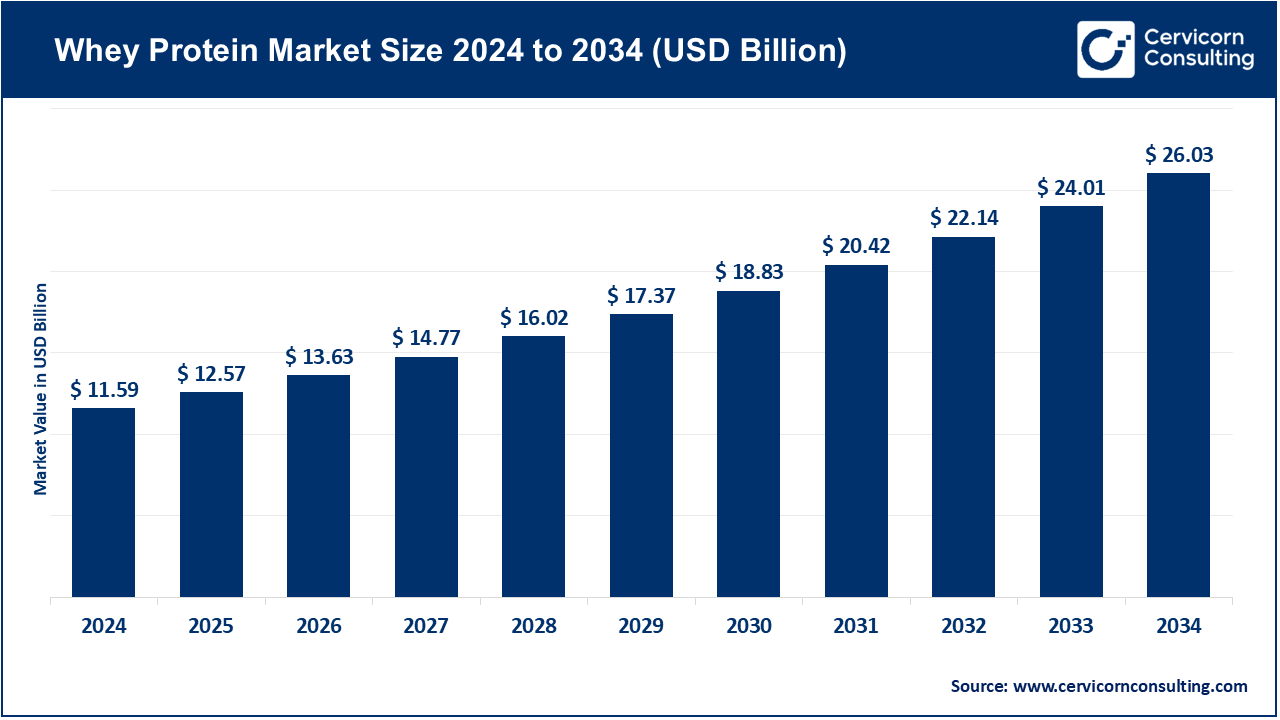Whey Protein Market Overview
The global whey protein market has experienced remarkable expansion over the last decade, fueled by growing health consciousness, the rise of fitness-oriented lifestyles, and increasing demand for functional food products. In 2024, the market size stood at nearly USD 11.59 billion and is projected to reach about USD 26.03 billion by 2034, advancing at a CAGR of 8.43% during 2025–2034.
Extracted as a by-product of cheese manufacturing, whey protein is a versatile ingredient extensively used in dietary supplements, sports nutrition, fortified foods, and beverages. Owing to its high digestibility and rich amino acid profile, it is a preferred choice for athletes, bodybuilders, and health-focused consumers.
Get a Free Sample: https://www.cervicornconsulting.com/sample/2731
Key Market Trends
1. Growing Demand for Plant-Based and Hybrid Protein Options
Rising cases of lactose intolerance, dairy allergies, and vegan dietary preferences are driving interest in plant-based alternatives. To address this shift, companies are developing hybrid products that combine whey with proteins like pea or rice.
-
Example: Brands such as Optimum Nutrition and MyProtein have released blends that cater to both dairy and plant protein consumers.
2. Technological Innovations in Processing
Advances in filtration and drying technologies are enhancing protein purity and functionality. Techniques like microfiltration and cross-flow filtration allow producers to create whey isolates with higher protein content, reduced fat, and minimal lactose.
3. Rise of Ready-to-Drink (RTD) Protein Beverages
Urban consumers and millennials are increasingly opting for convenience-driven products like RTD shakes and fortified drinks.
-
Example: MuscleBlaze and GNC Pro Performance are expanding their portfolios with RTD whey-based offerings targeting on-the-go users.
4. Supportive Regulatory Landscape for Supplements
Government bodies worldwide are encouraging the use of dietary supplements for nutritional well-being. Clear labeling, health claims, and safety regulations are improving consumer trust in whey protein products.
5. Expanding Fitness and Sports Culture
The growth of gym memberships, professional sports, and fitness-focused lifestyles is directly driving higher whey protein consumption. This trend is particularly strong in North America and Europe, where the protein supplement industry is well established.
Market Drivers
-
Rising Health Awareness
Growing recognition of protein’s benefits in muscle development, weight management, and wellness is a key driver. Surveys suggest that more than 60% of global consumers actively look for protein-rich products. -
Growth of Online Retail Channels
E-commerce platforms like Amazon, Flipkart, and niche nutrition websites are making whey protein more accessible, especially to younger, digitally savvy buyers. -
Government Programs & Nutrition Campaigns
Initiatives that promote protein-enriched diets in schools and healthcare programs are supporting market adoption. Countries such as India and the U.S. are boosting growth with favorable subsidies and policies. -
Product Diversification in Flavors & Formats
Brands are offering whey protein in multiple formats—powders, bars, and RTD drinks—with appealing flavors such as chocolate, vanilla, and fruit blends, which are gaining popularity in Asia-Pacific. -
Rising Disposable Income in Emerging Economies
Economic growth in India, Brazil, and China is enabling wider adoption of premium whey protein products.
Impact of Trends and Drivers
-
By Segment: Sports nutrition and supplements remain dominant, while functional foods are emerging as a fast-growing category.
-
By Region: North America leads as a mature market with established fitness culture, whereas Asia-Pacific is set for the fastest growth, backed by rising income levels and awareness.
-
By Application: Demand is rising for whey protein in snack bars, bakery items, and beverages, reflecting consumer preferences for taste and convenience.
Challenges & Opportunities
Challenges:
-
Lactose intolerance and dairy sensitivities could limit traditional whey demand.
-
High prices of premium protein products may restrict growth in price-sensitive markets.
Opportunities:
-
Expansion of plant-based whey alternatives and hybrid blends.
-
Rising adoption of RTD beverages and functional food formats.
-
Scope for innovation in flavoring and formulations aimed at children, seniors, and niche health groups.
Future Outlook
Growth will be shaped by evolving consumer preferences, advanced processing technologies, and strong demand from fitness-focused populations.
Emerging opportunities lie in Asia-Pacific and Latin America, as well as the rapidly expanding online retail ecosystem. Companies that innovate with diverse formulations, cater to special dietary needs, and strengthen their e-commerce presence will be best positioned for long-term success.
Contact Us for a Detailed Overview: Cervicorn Consulting

